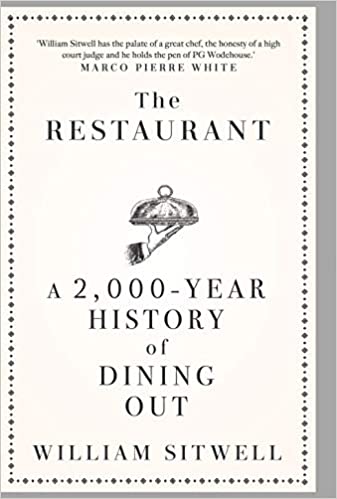You have /5 articles left.
Sign up for a free account or log in.
 The Restaurant: A 2,000-Year History of Dining Out by William Sitwell
The Restaurant: A 2,000-Year History of Dining Out by William Sitwell
Published in April 2020
Reading The Restaurant during a time when going to a restaurant is very different makes for a strange experience. I'm trying to remember when I last went to a sit-down restaurant, sat down, ordered and ate. You? It must have been some time in March. Or maybe February.
Restaurants in my small college town are starting to reopen. Many have been open for takeout all along. What is new is that they are setting up outside tables, six feet apart. Some local restaurants are not reopening, another casualty of COVID-19.
How good an idea is it to read a book that makes you want to eat at restaurants when (at least some of us) are wondering about the safety of dining out? Are you wondering?
The world might be divided into two kinds of people. There are those of us who are perfectly happy experiencing life mostly through books. These weeks and months of staying at home during COVID-19 have mostly been OK for me. I'd rather be home anyway.
Then there are others (like my wife) who love books but, for some strange reason, feel the need to experience the world firsthand. These people are, I imagine, having a harder time with stay-at-home orders.
Is it possible that academia overselects for the first type of individual?
Reading The Restaurant, for me, was almost as good as visiting one. Knowing something about the history of how restaurants came to be, how they evolved and where they may be going is deeply satisfying.
One of the joys of reading The Restaurant is that its author, William Sitwell, is clearly enjoying himself. He tells the story of the evolution of restaurants by picking and choosing among the places and stories that interest him most.
The book begins in A.D. 79 at the Inn of Primus and follows an imagined patron sampling Roman dining options the evening before the eruption of Mount Vesuvius. Much of what we think of as the modern restaurant experience (before modern meant takeout and social distancing) was present 2,000 years ago. Restaurants started as market food stalls, shifting to the eat-in establishments we knew and loved before the pandemic.
The two-millennium restaurant tour starts in Pompeii and ends at the most expensive restaurant in the world, a 12-person joint in Ibiza called Sublimotion that will set you back $2,000 a dinner. Although from reading Sitwell's description, and after watching a video about the place, I think that this place is more about conspicuous consumption than fine dining.
In between Pompeii and Ibiza, we sample the restaurant delights of 16th-century London public houses and the late-20th-century birth of the farm-to-table movement in Alice Waters's famed Chez Panisse. (Where you can't dine at the moment but can pick up farm boxes and pantry goods).
To get the full enjoyment of The Restaurant, I highly recommend the audiobook. Sitwell narrates his book, and since he is British, the narration is, of course, amazing.
Some readers may grow tired of the number of pages that Sitwell -- a restaurant critic by day (or night?) spends on the London restaurant scene. I didn't mind. The cultural references mostly went over my head. But the narration was so pleasing that I suspect Sitwell could read from a list of ingredients and I'd still be entranced.
Reading The Restaurant will not provide too much insight into the business of food service. One does come away with an appreciation of the devastating pressure that chefs and proprietors feel around the Michelin ranking system. Worrying about the ratings of a tire company seems to be a prison of one's own making. But the history of how the Michelin Guide came into being is entertaining.
The value of The Restaurant is to place dining out in the realm of cultural activity. As Sitwell points out, we don't go to fine restaurants because our stomachs are empty. Instead, the modern restaurant experience is just that -- an experience. We go to restaurants because we are hungry to have all of our senses engaged. Eating a meal out at a restaurant is a social as much as a gastronomical experience.
The joy of dining out -- be it at a local diner or a fancy restaurant -- is another one of those experiences that COVID-19 has taken from us. We can only hope that when a vaccine is created and widely distributed, the restaurants we love will still be around to seat us.
What books on restaurants, food and the food-service industry might you recommend?
The world of food can tell us much, I think, about our world of higher education. At least there are some lessons we can maybe try to learn.
Some books on restaurants, food and the food industry that I've reviewed in this space include:
- Hotbox: Inside Catering, the Food World's Riskiest Business
- Sweetbitter: A Novel
- Drive-Thru Dreams: A Journey Through the Heart of America's Fast-Food Kingdom
- Back of the House: The Secret Life of a Restaurant
- Blood, Bones & Butter: The Inadvertent Education of a Reluctant Chef
- The Way We Eat Now: How the Food Revolution Has Transformed Our Lives, Our Bodies, and Our World
- The Fate of Food: What We'll Eat in a Bigger, Hotter, Smarter World
- Coffee for One: How the New Way to Make Your Morning Brew Became a Tempest in a Coffee Pod
- Grocery: The Buying and Selling of Food in America
What are you reading?








